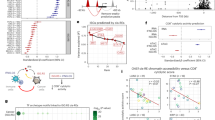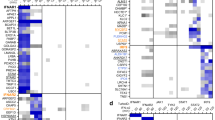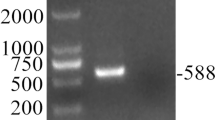Abstract
The type I interferons (IFNs) bind surface receptors, induce JAK kinases and activate STAT transcription factors to stimulate the transcription of genes downstream of IFN-stimulated response elements (ISREs). In this study, we demonstrate that IFNaR2, a subunit of the type I IFN receptor, is proteolytically cleaved in a regulated manner. Immunoblotting shows that multi-step cleavage occurs in response to phorbol ester (PMA) and IFN-α, generating both a transmembrane ‘stub’ and the intracellular domain (ICD), similar to Notch proteolysis. Isolated membrane fractions process IFNaR2 to release the ICD. A chimeric receptor construct is utilized to show that cleavage requires the presenilins and occurs in response to epidermal growth factor and protein kinase C-δ overexpression, as well as PMA and type I IFNs. Fluorescence microscopy demonstrates that a green fluorescent protein–ICD fusion localizes predominantly to the nucleus. A fusion between the ICD and the Gal4 DNA-binding domain represses transcription, in a histone deacetylase-dependent manner, of a Gal4 upstream activating sequence-regulated reporter, while overexpression of the ICD alone represses transcription of a reporter linked to an ISRE. Proteolytic cleavage events may facilitate receptor turnover or, more likely, function as a mechanism for signaling similar to that employed by Notch and the Alzheimer's precursor protein.
This is a preview of subscription content, access via your institution
Access options
Subscribe to this journal
Receive 50 print issues and online access
$259.00 per year
only $5.18 per issue
Buy this article
- Purchase on SpringerLink
- Instant access to full article PDF
Prices may be subject to local taxes which are calculated during checkout











Similar content being viewed by others
References
Baumann G and Frank SJ . (2002). J. Endocrinol., 174, 361–368.
Black RA . (2002). Int. J. Biochem. Cell Biol., 34, 1–5.
Brown MS, Ye J, Rawson RB and Goldstein JL . (2000). Cell, 100, 391–398.
Buxbaum JD, Liu KN, Luo Y, Slack JL, Stocking KL, Peschon JJ, Johnson RS, Castner BJ, Cerretti DP and Black RA . (1998). J. Biol. Chem., 273, 27765–27767.
Capell A, Grunberg J, Pesold B, Diehlmann A, Citron M, Nixon R, Beyreuther K, Selkoe DJ and Haass C . (1998). J. Biol. Chem., 273, 3205–3211.
Chill JH, Quadt SR, Levy R, Schreiber G and Anglister J . (2003). Structure, 11, 791–802.
Colamonici OR, Uyttendaele H, Domanski P, Yan H and Krolewski JJ . (1994). J. Biol. Chem., 269, 3518–3522.
Cruts M and Van Broeckhoven C . (1998). Hum. Mutat., 11, 183–190.
De Strooper B, Annaert W, Cupers P, Saftig P, Craessaerts K, Mumm JS, Schroeter EH, Schrijvers V, Wolfe MS, Ray WJ, Goate A and Kopan R . (1999). Nature, 398, 518–522.
Domanski P, Witte M, Kellum M, Rubinstein M, Hackett R, Pitha P and Colamonici OR . (1995). J. Biol. Chem., 270, 21606–21611.
Ebinu JO and Yanker BA . (2002). Neuron, 34, 499–502.
Edbauer D, Winkler E, Regula JT, Pesold B, Steiner H and Haass C . (2003). Nat. Cell Biol., 5, 486–488.
Esler WP, Kimberly WT, Ostaszewski BL, Ye W, Diehl TS, Selkoe DJ and Wolfe MS . (2002). Proc. Natl. Acad. Sci. USA, 99, 2720–2725.
Fan H and Derynck R . (1999). EMBO J., 18, 6962–6972.
Forman BM, Umesono K, Chen J and Evans RM . (1995). Cell, 81, 541–550.
Gschwendt M, Muller HJ, Kielbassa K, Zang R, Kittstein W, Rincke G and Marks F . (1994). Biochem. Biophys. Res. Commun., 199, 93–98.
Hinkle CL, Sunnarborg SW, Loiselle D, Parker CE, Stevenson M, Russell WE and Lee DC . (2004). J. Biol. Chem., 279, 24179–24188.
Improta T and Pine R . (1997). Cytokine, 9, 383–393.
Jones KA, Yamamoto KR and Tjian R . (1985). Cell, 42, 559–572.
Karlstrom H, Bergman A, Lendahl U, Naslund J and Lundkvist J . (2002). J. Biol. Chem., 277, 6763–6766.
Kimberly WT, LaVoie MJ, Ostaszewski BL, Ye W, Wolfe MS and Selkoe DJ . (2003). Proc. Natl. Acad. Sci. USA, 100, 6382–6387.
Kimberly WT, Xia W, Rahmati T, Wolfe MS and Selkoe DJ . (2000). J. Biol. Chem., 275, 3173–3178.
Kubota S, Mukudai Y, Hattori T, Eguchi T, Kondo S and Takigawa M . (2001). DNA Cell Biol., 20, 563–568.
Kumar KG, Tang W, Ravindranath AK, Clark WA, Croze E and Fuchs SY . (2003). EMBO J., 22, 5480–5490.
LaVoie MJ and Selkoe DJ . (2003). J. Biol. Chem., 278, 34427–34437.
Lee HJ, Jung KM, Huang YZ, Bennett LB, Lee JS, Mei L and Kim TW . (2002). J. Biol. Chem., 277, 6318–6323.
Levy DE and Darnell Jr JE . (2002). Nat. Rev. Mol. Cell Biol., 3, 651–662.
Li X, Leung S, Kerr IM and Stark GR . (1997). Mol. Cell. Biol., 17, 2048–2056.
Li YM, Lai MT, Xu M, Huang Q, DiMuzio-Mower J, Sardana MK, Shi XP, Yin KC, Shafer JA and Gardell SJ . (2000). Proc. Natl. Acad. Sci. USA, 97, 6138–6143.
Lutfalla G, Holland SJ, Cinato E, Monneron D, Reboul J, Rogers NC, Smith JM, Stark GR, Gardiner K, Mogensen KE, Kerr IM and Uzé G . (1995). EMBO J., 14, 5100–5108.
Martiny-Baron G, Kazanietz MG, Mischak H, Blumberg PM, Kochs G, Hug H, Marmé D and Schåchtele C . (1993). J. Biol. Chem., 268, 9194–9197.
May P, Reddy YK and Herz J . (2002). J. Biol. Chem., 277, 18736–18743.
Nadeau OW, Domanski P, Usacheva A, Uddin S, Platanias LC, Pitha P, Raz R, Levy D, Majchrzak B, Fish E and Colamonici OR . (1999). J. Biol. Chem., 274, 4045–4052.
Nguyen V-P, Saleh AZM, Arch AE, Yan H, Piazza F, Kim J and Krolewski JJ . (2002). J. Biol. Chem., 277, 9713–9721.
Ni CY, Murphy MP, Golde TE and Carpenter G . (2001). Science, 294, 2179–2181.
Okamoto I, Kawano Y, Matsumoto M, Suga M, Kaibuchi K, Ando M and Saya H . (1999). J. Biol. Chem., 274, 25525–25534.
Okochi M, Steiner H, Fukumori A, Tanii H, Tomita T, Tanaka T, Iwatsubo T, Kudo T, Takeda M and Haass C . (2002). EMBO J., 21, 5408–5416.
Rhee SG . (2001). Annu. Rev. Biochem., 70, 281–312.
Rio C, Buxbaum JD, Peschon JJ and Corfas G . (2000). J. Biol. Chem., 275, 10379–10387.
Sadowski I and Ptashne M . (1989). Nucl. Acid Res., 17, 7539.
Saleh AZ, Nguyen VP and Krolewski JJ . (2002). Biochemistry, 41, 11261–11268.
Soh JW, Lee EH, Prywes R and Weinstein IB . (1999). Mol. Cell. Biol., 19, 1313–1324.
Struhl G and Greenwald I . (2001). Proc. Natl. Acad. Sci. USA, 98, 229–234.
Takasugi N, Takahashi Y, Morohashi Y, Tomita T and Iwatsubo T . (2002). J. Biol. Chem., 277, 50198–50205.
Takasugi N, Tomita T, Hayashi I, Tsuruoka M, Niimura M, Takahashi Y, Thinakaran G and Iwatsubo T . (2003). Nature, 422, 438–441.
Uddin S, Sassano A, Deb DK, Verma A, Majchrzak B, Rahman A, Malik AB, Fish EN and Platanias LC . (2002). J. Biol. Chem., 277, 14408–14416.
Weihofen A and Martoglio B . (2003). Trends Cell Biol., 13, 71–78.
Weskamp G, Schlondorff J, Lum L, Becherer D, Kim TW, Saftig P, Hartmann D, Murphy G and Blobel CP . (2004). J. Biol. Chem., 279, 4241–4249.
Wilhelmsen K and van der Geer P . (2004). Mol. Cell. Biol., 24, 454–464.
Xia W and Wolfe MS . (2003). J. Cell Sci., 116, 2839–2844.
Yan H, Krishnan K, Greenlund AC, Gupta S, Lim JTE, Schreiber RD, Schindler C and Krolewski JJ . (1996a). EMBO J., 15, 1064–1074.
Yan H, Krishnan K, Lim JTE, Contillo LG and Krolewski JJ . (1996b). Mol. Cell. Biol., 16, 2074–2082.
Yoshida M, Kijima M, Akita M and Beppu T . (1990). J. Biol. Chem., 265, 17174–17179.
Yu G, Chen F, Levesque G, Nishimura M, Zhang DM, Levesque L, Rogaeva E, Xu D, Liang Y, Duthie M, St George-Hyslop PH and Fraser PE . (1998). J. Biol. Chem., 273, 16470–16475.
Acknowledgements
We thank H Young and D Selkoe for cell lines; B Weinstein, J Chan and G Carpenter for plasmids; K Nastiuk for antibody and M Brunda and J Rosa for IFNα. This work was supported by a grant from the National Institutes of Health (CA56862) to JJK.
Author information
Authors and Affiliations
Corresponding author
Rights and permissions
About this article
Cite this article
Saleh, A., Fang, A., Arch, A. et al. Regulated proteolysis of the IFNaR2 subunit of the interferon-alpha receptor. Oncogene 23, 7076–7086 (2004). https://doi.org/10.1038/sj.onc.1207955
Received:
Revised:
Accepted:
Published:
Issue date:
DOI: https://doi.org/10.1038/sj.onc.1207955
Keywords
This article is cited by
-
SheddomeDB: the ectodomain shedding database for membrane-bound shed markers
BMC Bioinformatics (2017)
-
BACE and γ-Secretase Characterization and Their Sorting as Therapeutic Targets to Reduce Amyloidogenesis
Neurochemical Research (2010)



